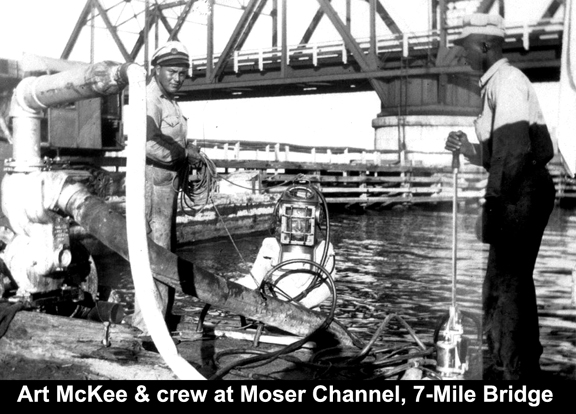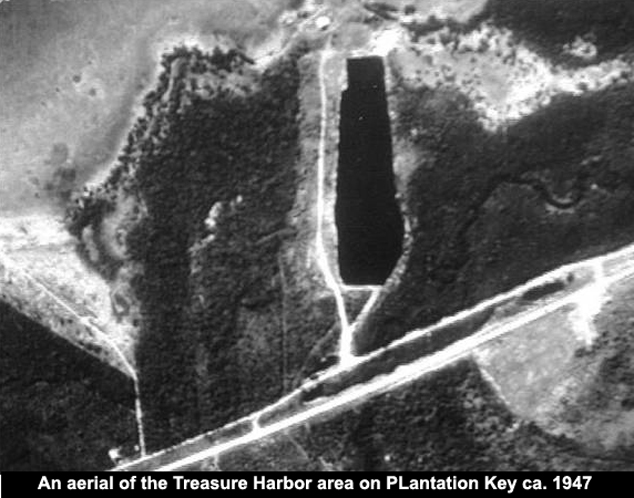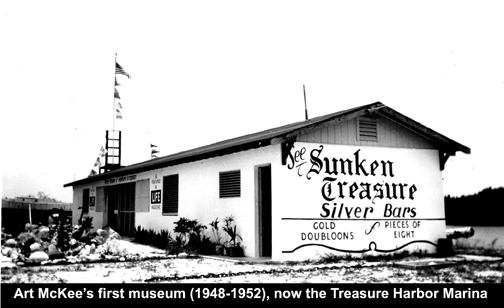|
- HISTORY OF THE UPPER KEYS -
Art "Silver Bar" McKee
The art, hobby or business of
treasure salvaging in the Florida Keys has been thoroughly thrashed out
in
the courts of law, but the triggering person of this was Arthur
McKee Jr. - better known as Art McKee but also as Art "Silver Bar"
McKee.
The 'silver bar' moniker was added after his bringing up of three 70
pound
bars of silver in one day near Gorda Cay, Bahamas. Born in Bridgeton,
NJ on November 2, 1910 the son of Art McKee Sr. and his wife Mabel. Art
had one brother and two sisters.
The following is a thumbnail sketch of Art McKee Jr. and for detail information please refer to the book "Galleon Hunt", by Robert "Frogfoot" Weller and/or the "History of Diving Museum" at MM 83, bayside where there is an entire section dedicated to Art McKee. In Bridgeton NJ, Art was always attracted to the water. In high school he played football and seriously tore a cartilage which plagued him the remainder of his life. He became a lifeguard at Sunset Beach and after a hurricane made contact with a local hard hat diver as a line tender which served an his apprenticeship. We are not certain the date, but we estimate around 1933. He married his local sweetheart, Sarah, who died when giving birth to their first child, Phyllis. Her grand parents adopted Phyllis who grew up without her biological father. Realizing how serious life could be, he left Bridgeton after learning from his doctor his leg injury was serious, so he headed for warmer waters. Upon arriving at Homestead,  FL in 1937, he learned that its WPA built
swimming pool was neglected and badly damaged, but was to repaired. The
waiting time was unknown, so he took on various jobs and easily fit
into the community. The pool was repaired and he became the lifeguard
quickly advancing to head lifeguard. The details are not documented.
but
somehow he saved enough money to buy a used hard hat diving rig in
Miami. He was so amicable and well like that friends flocked around him
to serve as his dive tenders. FL in 1937, he learned that its WPA built
swimming pool was neglected and badly damaged, but was to repaired. The
waiting time was unknown, so he took on various jobs and easily fit
into the community. The pool was repaired and he became the lifeguard
quickly advancing to head lifeguard. The details are not documented.
but
somehow he saved enough money to buy a used hard hat diving rig in
Miami. He was so amicable and well like that friends flocked around him
to serve as his dive tenders.Girl friends also found him attractive and he married his second wife, Sarah, and they walked a tight rope for some time, then a son, Wayne, was born. Again, the marriage was dissolved, and Art remained adventuresome, but remained working for the Homestead pool. The word spread about his capabilities of diving and retrieving objects as well as doing minor repair work. Homestead being the starting point for the construction of a new 18" water pipeline to Key West and Florida City also was the water well site. With Japanese bombing of Pearl Harbor, the work for the pipeline was accelerated as part of the war effort. Art having all the diving equipment, he worked himself into a job with the U.S. Navy which was actually building the pipeline for the Naval activities in Key West. The William's Company actually had the construction contract. It was not day after day work but Art McKee had all the work he could handle. Again he fell in love and married, Madge, of Homestead. This worked out good as Madge could watch the pool during his occasional work calls to the Keys. The steel pipe was hung under or to the sides of the fixed bridges, but at sites of the drawbridges it was ran underwater across the bottom. Then Art would be needed as well as occasional bridge pier inspections The pipeline job only lasted two years, but Art made new acquaintances throughout the Keys. Also, two more children was born - a son Rick and daughter Pat. His capabilities as an underwater diver also spread and opportunities availed themselves from time to time. One was meeting Windley Key fishing guide Reggie Roberts who showed him to 1733 Spanish wreck of the El Capitana, which later he pursued diligently. An important event was a phone call was from Charles Brookfield, past president of the Audubon Society. Charles needed an underwater diver to join other partners to raise artifacts for the 1695 sunken H.M.S. Winchester of Carysfort lighthouse. Sport diving was not popular at that time and the rigging of steel cables to the underwater required considerable underwater time. Brookfield had one experienced diver, but needed the second. The disappointment was the cannons were made of iron and not bronze, but there were 54 cannons and the publicity of raising the cannons of the HMS Winchester was considerable. The National Geographic published the story in December, 1941. Some of the cannons are at Lignum Vitae Key courtesy of Hugh Matheson. The connection with Charles Brookfield was significant and it soon paid off. Charlie Brookfield again called him at t  he Homestead swimming pool to
join a team ot divers at a thought-to-be Spanish 1656 wreck of the San Pedro near Gorda Cay (now Castaway Cay), Bahamas
and Charlie had a boat and crew. By this time the heavy cumbersome hard
hat
enclosed diving suits had been replaced in the warmer - shallower
waters
by the Miami made Miller-Dunn helmet and a weight belt - quick on and
off and very maneuverable to work with - but still an air compressor
was
required. Art also was now investigating other Spanish ship
wrecks by acquiring Spanish archival maps, and experimenting with
underwater 16 mm cameras. he Homestead swimming pool to
join a team ot divers at a thought-to-be Spanish 1656 wreck of the San Pedro near Gorda Cay (now Castaway Cay), Bahamas
and Charlie had a boat and crew. By this time the heavy cumbersome hard
hat
enclosed diving suits had been replaced in the warmer - shallower
waters
by the Miami made Miller-Dunn helmet and a weight belt - quick on and
off and very maneuverable to work with - but still an air compressor
was
required. Art also was now investigating other Spanish ship
wrecks by acquiring Spanish archival maps, and experimenting with
underwater 16 mm cameras. The result of the Gorda Cay expedition was Art McKee bringing up three silver bars - 60, 70 and 75 pounds. This find echoed throughout the world and Art was invited to the newly created mechanism of television. All of this motivated Art to make a living of treasure diving and step down from his Homestead job. Art took the gamble and created an incorporation "McKee's Museum of Sunken Treasure" selling 20,000 shares at $10 a share. Charles Brookfield was the vice-president. His dream of a 25 acre parcel a huge barrow pit on Plantation Key that he had accidentally discovered flying over while making a film in the Tavernier, FL area - see photo above. There  was
no exit canal to the ocean, but
contractor Alonzo Cothron could take care of that. The area today is
known as Treasure Harbor. His (the corporation's) first small museum
opened circa 1948 which he had outgrown before it was built from
artifacts brought in from the Capitana. A small sign with an arrow was
put on the highway announcing "Spanish Treasure." Life, Collier and National
Geographic magazines ran
treasure features. He was
following in time the McKinney family nearby and just south who were
building
the Theater of the Sea. was
no exit canal to the ocean, but
contractor Alonzo Cothron could take care of that. The area today is
known as Treasure Harbor. His (the corporation's) first small museum
opened circa 1948 which he had outgrown before it was built from
artifacts brought in from the Capitana. A small sign with an arrow was
put on the highway announcing "Spanish Treasure." Life, Collier and National
Geographic magazines ran
treasure features. He was
following in time the McKinney family nearby and just south who were
building
the Theater of the Sea.More artivfacts were brought weekly ashore - more than the small museum could display. The treasure fever was running rampant and public thirst was unquenchable, so a larger operation was planned - this time directly on the highway and with a steel vault large enough to walk around and then just lock the heavy steel door behind you. Of the original three silver bars, one was sold to the Smithsonian, and the other two were in the Homestead Bank. The plans were drawn in 1950 but a smaller version was built first. As the treasure craze spread, the state of Florida (others places also) declared all items in the Sovereign waters of State of Florida (From the coastline out to 3-miles) its, and disturbance or removal was crime. In 1952, Art obtained the first official Florida underwater salvage lease to work a large portion ot the Upper Keys - particularly the 1733 Spanish wrecks including the El Capitana from the State of Florida. There were legal clauses that insured the state w  ould
receive an
appropriate share of the artifacts that the state supervision rules. On January 5, 1953 Art McKee signed a
contract with Alonzo Cathron to build the 1950 planned museum with a
vault to be provided by am independent contractor. Yes, I know
there are records that indicate the year 1952, but the contract is
worded as 1953. ould
receive an
appropriate share of the artifacts that the state supervision rules. On January 5, 1953 Art McKee signed a
contract with Alonzo Cathron to build the 1950 planned museum with a
vault to be provided by am independent contractor. Yes, I know
there are records that indicate the year 1952, but the contract is
worded as 1953.The new museum space provided secured space for small intricate jewerly and coins as well as large cannons, piles of ballast stones and centuries old wooden planks. Art was also interested in moving the huge water-logged ship's framework of the Capitana from Hawk Channel to the rear of the museum for display to the public, as well as in the lagoon to view from his glass bottomed boat, Treasure Princess. With Florida clamping down of treasure salvaging, Art and others began looking more and more to other Caribbean countries. A life style change occurred in 1955 while film  ing
a
movie expedition to the Grand Cayman Islands. He met and married Gay
Bodden at a large ceremony at
Georgetown, Grand Bahamas - a marriage
that would last. ing
a
movie expedition to the Grand Cayman Islands. He met and married Gay
Bodden at a large ceremony at
Georgetown, Grand Bahamas - a marriage
that would last.In 1957 there was a serious confrontation over Art's State of Florida lease. Up until then the State seriously backed the lease and still did, but not for the El Capitana which was three and half miles off shore and outside of state waters. The crew of the ship Buccaneer directly confronted Art under water at the Capitana site and Art won the stand-off, but then the phone call came - The state only has jurdiction of the sea bottom out to three miles from shore. Soured with the outcome of the Florida lease, his sole access to the artifacts of the Capitana, Art again turned to traveling on expeditions and not limited to the Caribbean, but he alwayed returned to his Plantation Key museum. There were still many adventures ahead of him. Art died June 26, 1980 at the age of 69 and survived by his wife Janet (Gay), sons Art III and Kevin; daughters Phyllis, Patricia, and Karen, and one brother, Stacy of Colorado. BACK to PAGE ONE |

